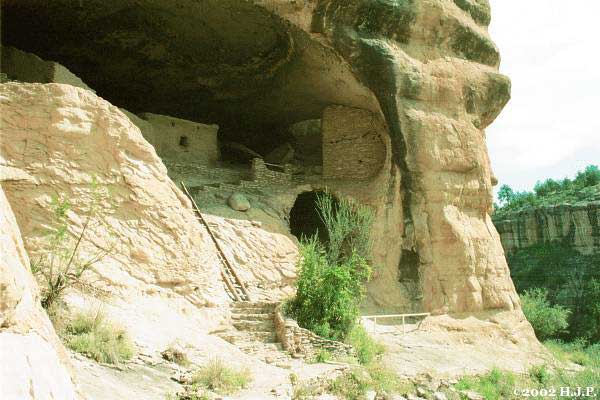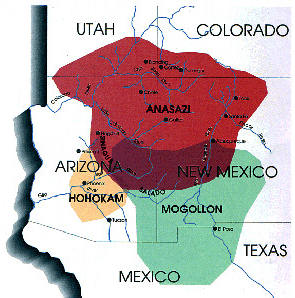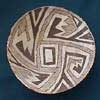| |
|
MOGOLLON
POTTERY
|
| |
|

|
|
Gila
Clif Dwellings, New Mexico |
|
|
|
|
Excellent information
from the Logan Museum
of Anthropology on line from
Beloit, Wisconsin |
|
All text and images are used courtesy
of the Logan Museum of Anthropology, Beloit College
(
http://www.beloit.edu/~museum//logan/index.html).
All objects illustrated are in the permanent collection of the Logan
Museum. |
|
|
|
|
|

Mogollon culture was fairly widespread and considerable variety
exists within pottery. Archaeologists have categorized Mogollon
pottery types into a number of wares, or groups of pottery
types which share the majority of structural and decorative
features. Within each ware, a historical sequence can be traced
from the beginnings of Mogollon culture to the end. |
Mogollon Brown Ware
This utility ware is found throughout Mogollon territory.
Mogollon Brown Ware is divided into several series, reflecting
geographic variations. Even so, Mogollon Brown Ware is generally
more homogeneous than Anasazi wares, with painted varieties being
much closer to their utility ware counterparts.
|
|

|
Mimbres Series
The Mimbres represent a culturally distinct subgroup of the
Mogollon. This series is treated in the Mimbres section of the
site.
|
|

|
Glenwood Series
The Glenwood Series includes some of the earliest of the
Mogollon types. San Francisco Red was common throughout
Mogollon history, while Mogollon Red-on-Brown and Three Circle
Red-on-White were the earliest of the painted types.
|
 |
Reserve Series
The Reserve Series includes the majority of Mogollon Brown
Ware plainware types. The Alma, Reserve and Tularosa
corrugated wares are often combined under the heading "Upper
Gila ".
|
 |
Rio
Grande Series
Pottery made along the Rio Grande River basin fall into
this series. Only one of our bowls derives from this area. |
|
Cibola White Ware
Cibola White Wares are found in east-central Arizona and
west-central New Mexico. The White Mountain Series is found in
predominantly Mogollon territories. The Cibola White Wares
are perhaps the most difficult to properly identify because they
are widespread and vary only subtly in painted decoration.
Furthermore, the "Cibola" range covers both Anasazi and Mogollon
areas, being found in eastern Arizona and western New Mexico.
Series distinctions allow us to separate types which are primarily
Mogollon from those which are Anasazi. The White Mountain Series
is the primary Mogollon sequence, to which we add the Socorro
Series. Within the White Mountain Series, distinctions rest almost
exclusively on differences in painted decoration. At the
Starkweather Ruin, from which most of our Cibola White Ware
pottery derives, there is tremendous variety within vessels which
have in the past been categorized as either "Reserve" or
"Tularosa". For these two types, we have created "styles" rather
than reclassifying the vessels to a different type altogether. For
example, a vessel which shows characteristics of Puerco
Black-on-white has been termed "Reserve Black-on-White, Puerco
Style". Those examples which were not found at the Starkweather
Ruin are categorized under the original types.
Material: The clay is white to
dark gray
Construction: Coiled-and-scraped
Paint: Mineral-based on white
slip
Firing: Reducing atmosphere
Forms: Bowls, jars, effigies,
ladles, scoops, seed jars and canteens
White Mountain Series |
|

|
Snowflake Black-on-White — 1100 - 1250
Early Pueblo III
Designs on this Cibola White Ware type consist of rather
busy patterns of interlocking solid elements and parallel
lines that tend to meet at right angles.
|
|

|
Reserve Black-on-White — 1030 - 1200
Late Pueblo II/Early Pueblo III
Several different painted styles exist within the Reserve
distinction in the pottery from the Starkweather Ruin. these
include the Red Mesa, Puerco, Escavada, Reserve, Wingate and
Mimbres Styles.
|
|

|
Tularosa Black-on-White — 1175 - 1300
Pueblo III
The Tularosa pottery from the Starkweather Ruin has been
divided into three styles - Wingate, Snowflake and Tularosa -
reflecting similarities in decoration with their source types. |
Socorro Series |
 |
Socorro Black-on-White — 950 - 1400
Early Pueblo II
Socorro Black-on-White is found between Albuquerque and
Socorro, New Mexico, and was the predominant black-on-white
type in that area for several centuries. |
|
White Mountain Red Ware
This ware is found in the east-central part of
Arizona and west-central part of New Mexico. The White Mountain
Red Wares pose a problem similar to that of the Cibola White
Wares. The range of this ware extends across both Anasazi and
Mogollon areas, being found in eastern Arizona and western New
Mexico. As with the Cibola White Wares, series distinctions allow
us to separate types which are primarily Mogollon from those which
are Anasazi, and again the White Mountain Series is the primary
Mogollon sequence.
Material: The clay is white to
gray, or yellow to orange
Construction: Coiled-and-scraped
Paint: Mineral or organic-based,
(glaze paints are late) on thick limonite or hematite slip.
Firing: Oxidizing atmosphere
Forms: Bowls, jars, pitchers,
dippers, canteens, effigies
White Mountain Series
|
 |
Pinedale Polychrome — 1275 - 1350
Late Pueblo III/Pueblo IV
The first glaze paints were used in this White Mountain Red
Ware type, which have distinctive black interior designs and
exterior motifs accented with white.
|
|

|
Cedar Creek Polychrome — 1300 - 1375
Pueblo IV
This White Mountain Red Ware type has interlocking solid
and hatched elements, one or both outlined in white.
|
 |
Four
Mile Polychrome — 1325 - 1400
Pueblo IV
Interior patterns on this White Mountain Red Ware type are
asymmetrical and outlined in white, while exteriors bands of
regularized interlocking motifs. |
|
Chihuahua Red Ware
This ware is found primarily in the northernmost parts
of Mexico, but was traded into the southern parts of Arizona and
New Mexico. |
From:
http://www.beloit.edu/~museum/logan/southwest/mogollon/mogollon.htm |
|
|
|
| |
|
 ClayHound Web
- Mogollon
Pottery
ClayHound Web
- Mogollon
Pottery










